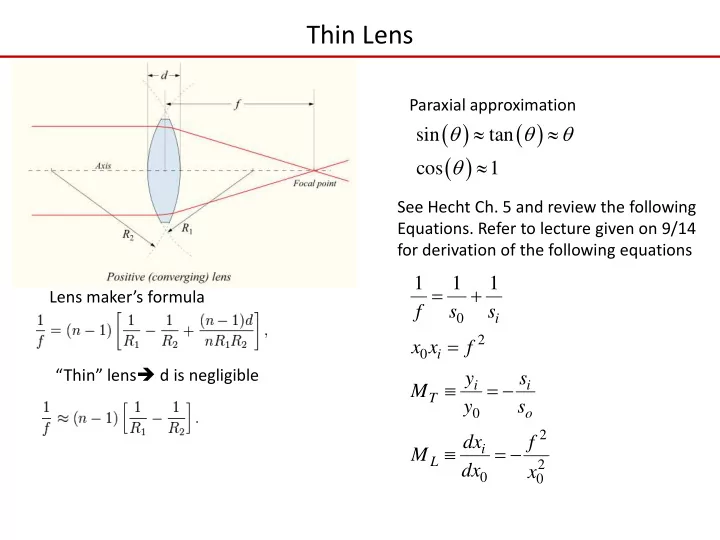

Thin Lens Paraxial approximation ( ) ( ) θ ≈ θ ≈ θ sin tan ( ) θ ≈ cos 1 See Hecht Ch. 5 and review the following Equations. Refer to lecture given on 9/14 for derivation of the following equations 1 1 1 = + Lens maker’s formula f s s 0 i = 2 x x f 0 i “Thin” lens d is negligible y s ≡ = − i i M T y s 0 o 2 dx f ≡ = − i M L 2 dx x 0 0
Thin Lens 1 1 1 = + f S S 1 2 S = 2 M T S 1 Simulation Thin Lens: link Thin lens combination: http://silver.neep.wisc.edu/~shock/tools/ray.html
Converging and Diverging Lenses: Ray Diagrams
Summary : Real and Virtual Images
Vendors for Optics, Optical Design Software Optical design –Code V – Oslo OSLO EDU http://www.lambdares.com/education/oslo_edu/ –Zemax Optics & opto-mechanics –Newport / New Focus –Opto-Sigma –Thorlabs –Edmund Optics
Transfer Matrix Method (not covered yet) The ray transfer matrix method (ABCD matrix) is a commonly used method to deal with complicate multiple optical elements , see, for example: http://en.wikipedia.org/wiki/Ray_transfer_matrix_analysis We may cover this method if time permitted.
Invisible Cloaks?
Negative Refraction Resources • http://en.wikipedia.org/wiki/Negative_refraction • http://en.wikipedia.org/wiki/Metamaterial • “Reversing Light: Negative Refraction”, John Pendry and David Smith, Physics Today (Dec 2003). • John Pendry’s presentation slides – http://www.cleoconference.org/materials/07pendry.pdf
Recommend
More recommend